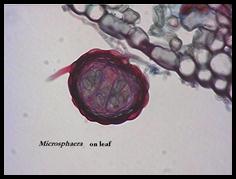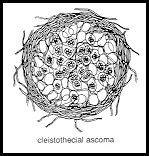


 النبات
النبات
 الحيوان
الحيوان
 الأحياء المجهرية
الأحياء المجهرية
 علم الأمراض
علم الأمراض
 التقانة الإحيائية
التقانة الإحيائية
 التقنية الحيوية المكروبية
التقنية الحيوية المكروبية
 التقنية الحياتية النانوية
التقنية الحياتية النانوية
 علم الأجنة
علم الأجنة
 الأحياء الجزيئي
الأحياء الجزيئي
 علم وظائف الأعضاء
علم وظائف الأعضاء
 الغدد
الغدد
 المضادات الحيوية
المضادات الحيوية|
Read More
Date: 17-11-2015
Date: 17-11-2015
Date: 2025-02-27
|
Phylum. Dikaryomycota
Sub Phylum. Ascomycotina
Class. Hemiascomycetes:
the one unifying characteristic is that all members have no ascocarp.
Order: Taphrinales
This is an outlying group which causes serious diseases of some plants in the Rosaceae (e.g., Taphrina deformans causing peach leaf curl).
Taphrina deformans:
This fungus attacks peach trees and cause peach leaf curl. It produces an exposed layer of asci (naked asci) on the surface of the host leaf . Since there is no surrounding or supporting fungal tissue, there is nothing we could call an ascoma.
Symptoms of leaf curl appear in the spring. The leaves become thickened, distorted and often yellow or reddish in colour.
Order: Endomycetales
This order concern us economically because they include the yeast, so important in industry.
Family: Endomycetaceae
Schizosaccharomyces octosporus
Is an example of a fission unicellular yeast, which also produce asci and eight ascospore. Its better known as the brewer's yeast.
Family: Saccharomycetaceae
Saccharomyces cerevisiae
(baker's yeast) is probably the most studied species of fungi because of its economic importance in the wine industry. reproducing asexually by budding, and produce four ascospore during sexual phase.
Class: Plectomycetes:
In this class all they have in common is the production of closed ascocarp or cleistothecium.


Order: Erysiphales:
All members of this order are obligate parasites on leaves and fruits of higher plants, causing diseases called powdery mildews because the affected parts have a white, mealy appearance produced by masses of conidiophore.
Erysiphe graminis
The cleistothecia are dark brown, globose, with many unbranched appendages. There are multiple asci within each cleistothecium. This genera causes powdery mildew disease on plants of Graminae.
Uncinula sp.
There are several asci per cleistothecium. The cleistothecia have appendages that may or may not be branched, but always have curved tips. Uncinula sp. causes powdery mildew disease of grape vines.
Podosphaera leucotricha
Cleistothecia of genera contain a single ascus and have flattened, dichotomously branched appendages. causes powdery mildew disease of apple.



|
|
|
|
دخلت غرفة فنسيت ماذا تريد من داخلها.. خبير يفسر الحالة
|
|
|
|
|
|
|
ثورة طبية.. ابتكار أصغر جهاز لتنظيم ضربات القلب في العالم
|
|
|
|
|
|
|
العتبة العباسية المقدسة تستعد لإطلاق الحفل المركزي لتخرج طلبة الجامعات العراقية
|
|
|